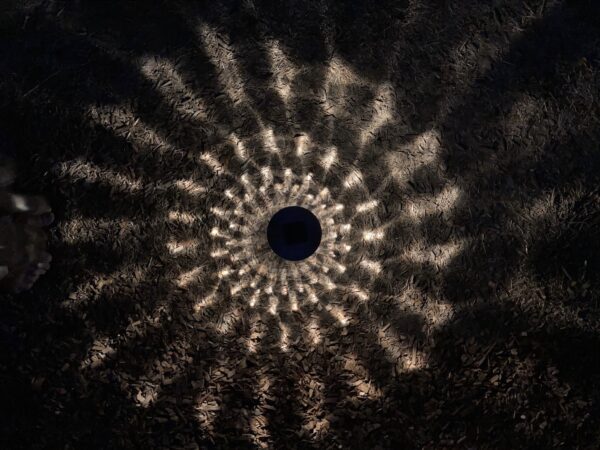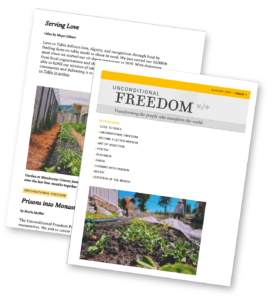by Margot Koch
Lay ordained in the Zen Buddhist tradition, Margot Koch is an artist who has practiced zen and meditated for nearly forty years. She was a school teacher, focusing on disabled learners for twenty-five years, as well as teaching art and eventually public speaking in a small alternative school she helped co-found. Currently she illustrates books and facilitates speaking groups that focus on relational presence.
Settling onto rolled yoga mats on the seats of huge, molded plastic chairs at one corner of the vast day room in Unit 509 of Chowchilla Women’s Facility, a massive low-lying complex of concrete buildings and walkways surrounded by chain link fences that bristle with barbed wire, a half dozen women sat quietly, eyes closed to the sunlight streaming in through the window, legs folded beneath us, meditating.
It was 6:35 am, and we were silently bringing a dream to life.
The dream, for me, was actually threefold. One was a personal, longtime desire to share nearly forty years of experience in meditation and Zen practice with an incarcerated population. The second was part of a powerful intention of the Unconditional Freedom Project to bring the model of a living monastery into existence in an established prison. The last but central to all other dreams, was of the women themselves: to find some quiet, maybe even peace, inside.
Nobody outside prison needs to be told that the inside can be stark and brutal. We’ve seen representations of it in the media, and in person it acts on all the senses: the guards’ announcements suddenly tearing through loudspeakers at near distortion levels any moment of the day, the loudness of the incarcerated women themselves — some threatening, some performing, some just trying to be heard and seen, as others try just as hard to disappear entirely.
Except for hints in the forest of tattooed limbs and faces, there’s a stark absence of color in the unit. The walls are blank, the chairs are gray, the clothes are drab. There is, evidently, an outlawing of beauty in prison, yet it hasn’t entirely worked because there is still such beauty in the outlaws themselves. Much more than one might imagine possible.
My first experience of leading a meditation period in Unit 509 at Chowchilla was in March, at an evening gathering that was intended to be the first of two, with twenty women in each. Instead, we found ourselves facing a crowd of about forty individuals.
The self-selected group was sitting in those hulking gray seats on one side of the enormous day room, while other women milled about talking, yelling to or at each other; mostly trying hard to look entirely oblivious to the gathering so unusual in their unit.
509 is not known for its social services. It is the unit with the worst behaviors in the entire facility. A lot of these women are evidently considered intractable, incorrigible, irreformable.
I have come to think of that first meditation in the prison as my first attempt as well at a yelling meditation. If I’d learned anything as a classroom teacher, it was that the harder you try to control some people, the more they’ll resist anything you want to teach them. These were definitely some of those people. So when it was time to begin, I began yelling over the noise, suggesting everyone try to find whatever comfortable position they could while also keeping their backs as straight as possible. I yelled to them to close their eyes, to be aware of their hearts beating, watch their own breath. I yelled a suggestion that they not try to change whatever they found inside or out — not the blare of the loudspeaker, the roar of the blowing fans, the incessant talk outside the circle — but if they chose, they might try counting their breaths. One to ten. And if they lost track, they could go back and start again. At one.
It was a challenge, but I did think I felt something shift in the room. Some women later commented with surprise at the quiet they’d felt settling in themselves. The faces of those who approached me at the evening’s conclusion said more. They were open and friendly, and I trusted those faces. I suspect the bullshit meter in incarcerated people is far higher than in most of us who have learned to get along “on the outside.”
Two months later, back in that same enormous room with the glass guard station in the middle, at six o’clock a.m., far fewer participants had shown up for yoga and sitting. The hour was early, the practices new and unfamiliar. But the women who came stretched out on their yoga mats, following Marla’s sure-handed lead through the asanas and breathing exercises. By the time we came to our spot under the window, faces were glowing. The room was finally silent. Eyes closed and breathing slowed as I led them, as I had been taught, to look inside for a place of stillness.
Later that week when Oprah Winfrey flew in to Chowchilla, as she does once a month to lead a book club, a woman who had been attending Unconditional Freedom’s morning yoga and meditation told Oprah that she’d suddenly come to understand some of what was being said in Eckhardt Tolle’s Power of Now, one of the books they’d recently finished. She said that for the very first time — in meditation — she had experienced a quieting of her mind (Oprah told her that she had recently meditated in the middle of the set of The Color Purple to quiet her own mind.)
Deep meditation practice can harbor no goals beyond itself. But if it helps people find freedom inside themselves, there will be the realized aim of the Unconditional Freedom Project; a worthy goal for a monastery.

 Get access to the monthly Rehumanization Magazine featuring contributors from the front lines of this effort—those living on Death Row, residents of the largest women’s prison in the world, renowned ecologists, the food insecure, and veteran correctional officers alike.
Get access to the monthly Rehumanization Magazine featuring contributors from the front lines of this effort—those living on Death Row, residents of the largest women’s prison in the world, renowned ecologists, the food insecure, and veteran correctional officers alike.